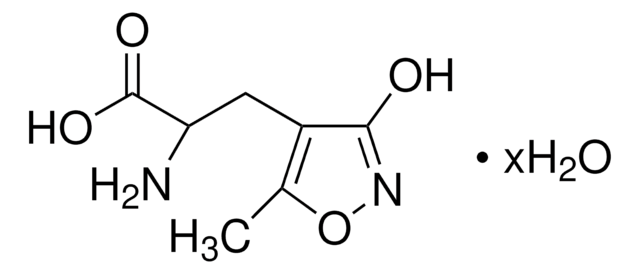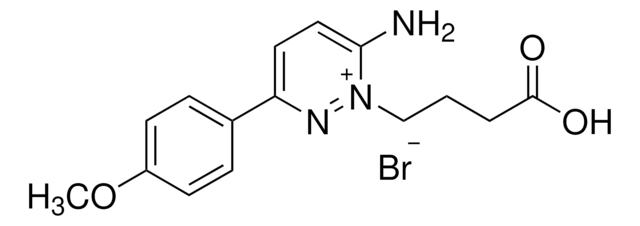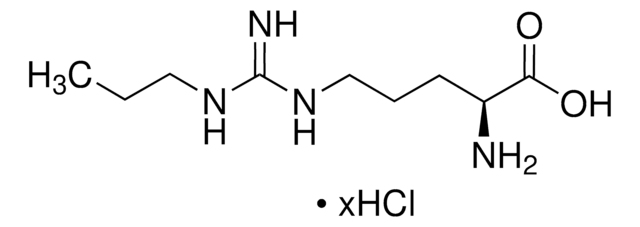所有图片(4)
About This Item
经验公式(希尔记法):
C5H9NO4
CAS号:
分子量:
147.13
Beilstein:
1724431
MDL號碼:
分類程式碼代碼:
12352209
eCl@ss:
32160406
PubChem物質ID:
NACRES:
NA.32
推荐产品
product name
N-甲基- D -天冬氨酸, ≥98% (TLC), solid
化驗
≥98% (TLC)
形狀
solid
技術
cell culture | mammalian: suitable
顏色
white
mp
189-190 °C
應用
cell analysis
SMILES 字串
CN[C@H](CC(O)=O)C(O)=O
InChI
1S/C5H9NO4/c1-6-3(5(9)10)2-4(7)8/h3,6H,2H2,1H3,(H,7,8)(H,9,10)/t3-/m1/s1
InChI 密鑰
HOKKHZGPKSLGJE-GSVOUGTGSA-N
基因資訊
human ... GRIN1(2902) , GRIN2A(2903) , GRIN2B(2904) , GRIN2C(2905) , GRIN2D(2906) , GRINA(2907)
rat ... Gria1(50592) , Grik1(29559) , Grin2a(24409)
正在寻找类似产品? 访问 产品对比指南
一般說明
N-甲基-D-天冬氨酸(NMDA)是大鼠神经系统和内分泌腺中的内生分子。NMDA在腺垂体、下丘脑、脑和睾丸中以低水平(nmol/g)存在。NMDA通过S-腺苷甲硫氨酸依赖性酶(也称为NMDA合酶)对D-Asp衍生而来。
應用
N-甲基-D-天冬氨酸已用于诱导N-甲基-d-天冬氨酸(NMDA)的毒性,视网膜细胞培养物补充有NMDA。
生化/生理作用
N-甲基-D-天冬氨酸(NMDA)对于垂体中促黄体激素和PRL(催乳素),以及下丘脑中的GnRH(促性腺激素释放激素)的释放起着关键作用。它可作为NMDA型谷氨酸受体的特异性激动剂。
兴奋毒性氨基酸。NMDA型谷氨酸受体的原型激动剂,可调节离子通道;在长时程增强、缺血和癫痫中起重要作用。
儲存類別代碼
11 - Combustible Solids
水污染物質分類(WGK)
WGK 3
閃點(°F)
Not applicable
閃點(°C)
Not applicable
個人防護裝備
Eyeshields, Gloves, type N95 (US)
其他客户在看
Calpain- and caspase-mediated aII-spectrin
and tau proteolysis in rat cerebrocortical
neuronal cultures after ecstasy or
methamphetamine exposure.
and tau proteolysis in rat cerebrocortical
neuronal cultures after ecstasy or
methamphetamine exposure.
Warren MW
The International Journal of Neuropsychopharmacology, 9, 1-11 (2006)
Occurrence of D-aspartic acid and N-methyl-D-aspartic acid in rat neuroendocrine tissues and their role in the modulation of luteinizing hormone and growth hormone release.
D'Aniello A
Faseb Journal, 14(5), 699-714 (2000)
Guendalina Olivero et al.
Molecular neurobiology, 56(9), 6142-6155 (2019-02-09)
Mouse hippocampal glutamatergic nerve endings express presynaptic release-regulating NMDA autoreceptors (NMDARs). The presence of GluN1, GluN2A, GluN2B, and GluN3A subunits in hippocampal vesicular glutamate transporter type 1-positive synaptosomes was confirmed with confocal microscopy. GluN2C, GluN2D, and GluN3B immunopositivity was scarcely
N-methyl-D-aspartic acid (NMDA) in the nervous system of the amphioxus Branchiostoma lanceolatum.
D'Aniello S
BMC Neuroscience, 8:109 (2007)
Juan Ding et al.
Neural regeneration research, 14(12), 2112-2117 (2019-08-10)
N-methyl-D-aspartate receptor hypofunction is the basis of pathophysiology in schizophrenia. Blocking the N-methyl-D-aspartate receptor impairs learning and memory abilities and induces pathological changes in the brain. Previous studies have paid little attention to the role of the N-methyl-D-aspartate receptor subunit
我们的科学家团队拥有各种研究领域经验,包括生命科学、材料科学、化学合成、色谱、分析及许多其他领域.
联系技术服务部门









